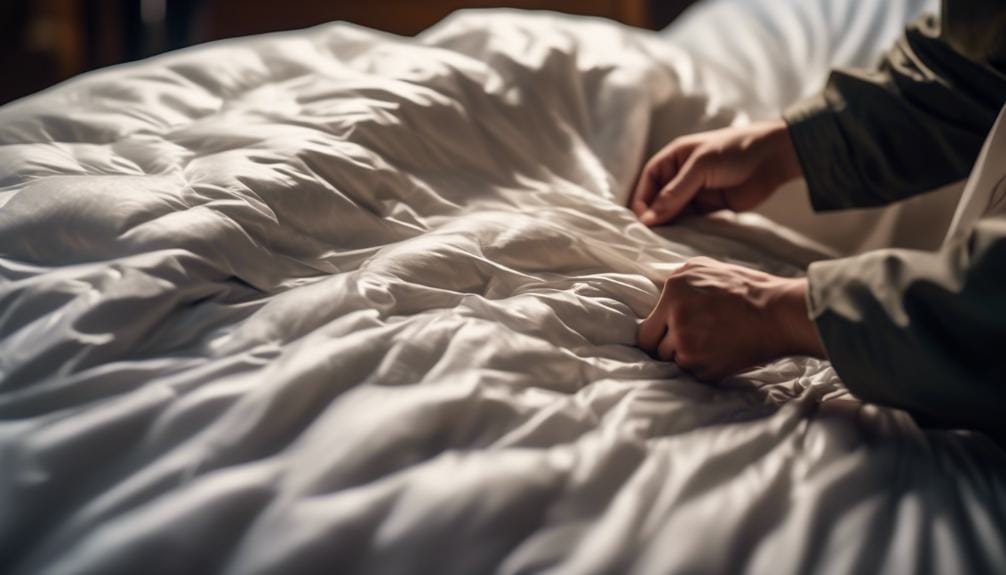Why Are the Feathers Coming Out of My Duvet? Troubleshooting Tips
Are you waking up to a trail of feathers from your duvet, wondering why are the feathers coming out of my duvet? You’re not alone in this frustration.
Feathers escaping from your duvet can be bothersome, but fear not, there are practical solutions that can help resolve this problem.
If you’ve ever wondered why this happens and how to prevent it from occurring, keep reading to discover some troubleshooting tips that can help you take control of the situation and keep your duvet in top condition for longer.
Key Takeaways
- Proper maintenance and care, such as using a duvet cover and following specific care instructions, can prevent feather leakage from the duvet.
- Identifying wear and tear, such as thinning fabric or loose stitching, can help determine if the feather loss is due to normal wear and tear or a defect.
- Exploring alternative cover options, such as using a zippered duvet cover made from high thread count fabric, can provide added protection and minimize feather leakage.
- Seeking professional assistance, such as contacting the company for abnormal feather loss or consulting with professionals for comforter replacement or repair, can ensure a durable and long-lasting down comforter.
Understanding Duvet Construction

To ensure the longevity and quality of your duvet, understanding its construction and the factors affecting feather retention is essential.
The thread count of the fabric weave plays a significant role in keeping the feathers inside the duvet. Look for a tight stitching technique, such as baffle construction, which reduces the chances of feathers escaping.
Additionally, proper drying methods are crucial to prevent feather loss and maintain the duvet’s fluffiness and warmth. Consider using a protective, zippered liner or duvet cover with high thread count fabric to contain the feathers and prevent leaks.
Also, the type of feather filling and its distribution within the duvet can impact the potential for feathers to come out.
Proper Maintenance and Care

For optimal maintenance and care of your duvet, consider using a duvet cover to protect the outer fabric and feather filling from damage and reduce the need for frequent washing. This will help keep the feathers inside and prevent them from poking through the fabric.
When it’s time to wash your duvet, it’s best to use a commercial washer or have it dry-cleaned to prevent flattening and feather leakage. Properly drying the duvet using low heat in a commercial dryer or air drying without wetting it can help maintain its fluffiness and prevent feather loss.
Additionally, making your bed each morning and regularly fluffing the duvet can prevent matting of feathers and avoid leaking fill. Following specific care instructions from the manufacturer and using a protective, zippered liner can also help maintain your duvet’s quality.
Identifying Wear and Tear

Inspecting the outer fabric weave for signs of thinning or damage is crucial in identifying wear and tear in your duvet, as these issues can contribute to feather leakage. Additionally, checking for loose or damaged stitching is important, as this can allow feathers to escape. Look for areas where the fabric may be flattened or compressed, as this can lead to feather dispersal. Examine the comforter for any visible defects such as tears or holes, which can result in feather loss. Keep an eye out for excessive feather loss, as it may indicate wear and tear or a defect in the comforter. The table below summarizes the key points to consider when identifying wear and tear in your comforter.
| Key Points |
|---|
| Thinning or damaged fabric weave |
| Loose or damaged stitching |
| Flattened or compressed fabric |
| Visible defects such as tears or holes |
Exploring Alternative Cover Options

Consider using a duvet cover to provide added protection to your comforter and minimize the risk of feather leakage due to sudden movements or spills.
A duvet cover is like a large pillowcase that goes over your comforter. It acts as a barrier between the outer fabric and the comforter, preventing feathers from escaping.
Look for zippered duvet covers made from high thread count fabrics to ensure maximum protection. Opt for a cover with a soft, breathable inside to keep your comforter cozy and comfortable.
Additionally, choose a cover that complements your bedroom decor and is easy to remove and wash. Investing in a quality duvet cover is an effective way to maintain your comforter’s integrity and prevent feather leakage.
Seeking Professional Assistance

If you have tried the recommended troubleshooting steps and are still experiencing feather leakage from your duvet, it may be time to seek professional assistance to address the issue effectively. Contact the company to report abnormal feather loss, as it may indicate a defect in the comforter. Seeking professional guidance from the manufacturer or retailer is crucial, especially if replacement of the comforter is necessary. Addressing the issue promptly with professional assistance ensures a durable and long-lasting down comforter. Professional repair services may also be required in case of significant damage to the comforter or loss of fill. By consulting with professionals, you can ensure that your comforter, especially those with higher thread counts, effectively keeps the feathers inside the comforter, providing you with the comfort and quality you desire.
| Seeking Professional Assistance |
|---|
| Contact the company for abnormal feather loss. |
| Seek professional guidance for comforter replacement. |
| Consider professional repair services for significant damage. |
Frequently Asked Questions
Why Is My Duvet Shedding?
Your duvet may shed due to loose stitching or wear. Protect it with a duvet cover and clean it properly to prevent feather leakage. If issues persist, contact the company for potential replacement.
How Do You Make a Feather Duvet Fluffy Again?
To make your feather duvet fluffy again, simply fluff the entire comforter to aerate the down fill and prevent matting. Regularly shaking and airing out the duvet can also help maintain its fluffiness and prevent feathers from clumping.
Why Does My Duvet Keep Coming Out of the Cover?
If your duvet keeps coming out of the cover, it could be due to the cover being too large, not properly secured, or made of slippery material. Check the cover size and consider using clips to hold it in place.
What Is the Lifespan of a Feather Duvet?
A feather duvet’s lifespan ranges from 5 to 15 years, based on care and usage. Regular fluffing and a protective cover can extend its life. Over time, loss of loft and insulation is natural.
Conclusion
In conclusion, taking care of your duvet is key to preventing feather leakage. Remember to check the thread count, avoid abrupt movements, and use a duvet cover for protection.
Proper cleaning and drying methods can also help maintain the duvet’s fluffiness. If you’re still experiencing issues, consider seeking professional assistance or exploring alternative cover options.
By following these troubleshooting tips, you can keep your duvet in top condition and minimize feather loss.
